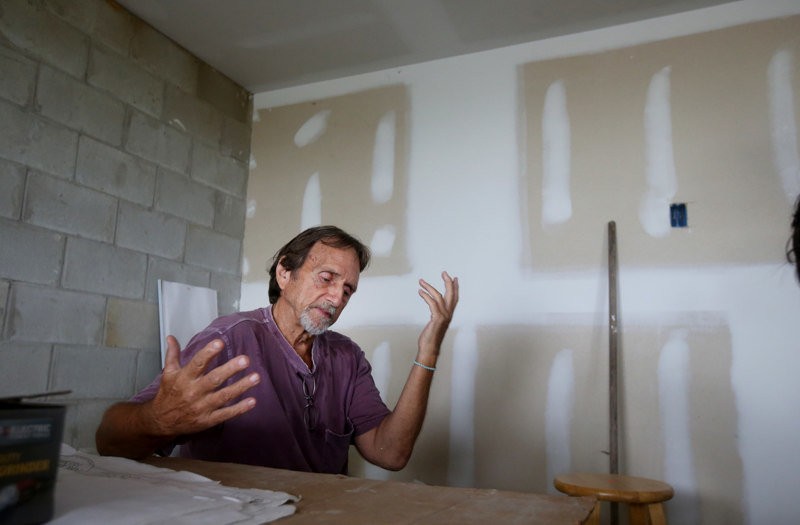You can believe a detailed academic survey of about 500 households, or you can believe your own eyes.
Either way, a nonprofit organization’s report card released today on the Hurricane Sandy recovery as the five year anniversary nears says the “storm after the storm” is still very real to many people.
“The storm after the storm” or the “disaster after the disaster” is how many Sandy victims describe their road to recovery. And while the word “road” implies straight and smooth, it is more accurate to say the “obstacle course to recovery.”
Think of one of those Tough Mudder races – that’s what rehabbing after Sandy has been like for many victims. Bogged down in the deep muck of government paperwork. Climbing the high walls of insurance company obstinance and, in some cases, outright fraud. Walking the balance beams of finding a reliable contractor.
In the hard hit areas of the Barneget and Raritan bays, it is very clear the recovery is far from over. Houses remain boarded or vacant and lots are empty. “For Sale” signs dot the landscape. Construction continues and for every few homes that look rebuilt and inhabited, there is another on the block that continues to languish.
As of Sept. 30, the state Department of Community Affairs, which has handled the Sandy recovery, reports that 2,000 of the 7,572 homeowners in the Reconstruction, Rehabilitation, Elevation, and Mitigation (RREM) program still await a certificate of occupancy (CO) for their homes. Of 386 people in low- and middle-income rebuilding programs, 208 remain without a CO. No CO means you can’t go home.
The number of primary homeowners still out of their homes is elusive. The state keeps track only of the people who entered the RREM program, which awarded grants to elevate homes to levels that meet new FEMA flood insurance requirements.
No one is even counting those whose damaged property was a second residence because they are not eligible for any government grants or loans.
Amanda Devecka-Rinear, an experienced activist who lives several steps from the Barnegat Bay on Cedar Bonnet Island, started the New Jersey Organizing Project (NJOP) in 2014 to advocate for Sandy victims stuck in the morass of the recovery.
“It’s impossible to tell how many people are still out,” she said. “There were estimates that 50,000 homeowners and renters were forced from their primary homes after the storm. At one point, the state said there were 12,000 people in RREM. Where did they all go?”
Earlier this year, her organization attempted to find out. Volunteers spread out in the most impacted areas with detailed questionnaires about Sandy victims’ recovery experiences. Surveys were done in Toms River, Union Beach, Beach Haven West, Ortley Beach, Atlantic City, and four other devastated areas. In many cases, volunteers interviewed people directly. Overall, several thousand people had access to the survey.
NJOP received 551 responses, not a huge sampling, but enough to draw some attention to the success of the recovery house-to-house. The 56-page report, issued by the New Jersey Resource Project, is titled opens in a new window“The Long Road Home: Superstorm Sandy Still Taking a Toll Five Years Later.” Among the findings are:
- 22 percent of people surveyed are still not home.
- 77 percent said they did not get enough insurance money to finish rebuilding and had to borrow from their retirement savings or other funds, Small Business Association loans or credit cards.
- More than 70 percent said the anxiety and stress during the recovery led to physical or mental health problems, including depression, post-traumatic stress, and respiratory problems due to mold conditions.
- 56 percent say they have had trouble keeping up with bills, or even affording food since the hurricane.
- While 50 percent of homeowners reported damages of $150,000 or more, only seven percent received National Flood Insurance compensation in that amount.
- 20 percent of people in the state RREM program have been told that they owe money to the grant programs and 90 percent of that number said they could not afford to the pay back the money.
- 41 percent lost their jobs or had their livelihood adversely effected.
- 32 percent fell behind on mortgages/rent payments and taxes on their Sandy-damaged homes.
While the sample is small, the people involved in gathering the information have vast experience with Sandy victims.
Jessica Limbacher, from Volunteer Lawyers for Justice, is one of the authors of the survey and has represented several hundred Sandy victims.
“One of the most important things we have learned – and which this survey confirms – is that people need ongoing assistance, even now five years later,” she said.
The point of the survey, Devecka-Rinear said, it not just to quantify misery. It’s to help the federal, state and local governments prepare for the next time – and even help navigate the recoveries of hurricanes Harvey, Irma and Maria.
“Our communities learned these lessons the hard way,” she said. “We have solutions to help New Jersey families and make sure no one in any state has to go through what we have. Shame on us if we don’t listen.”


